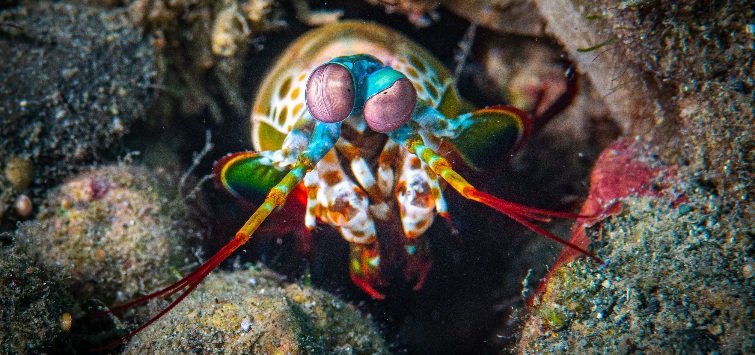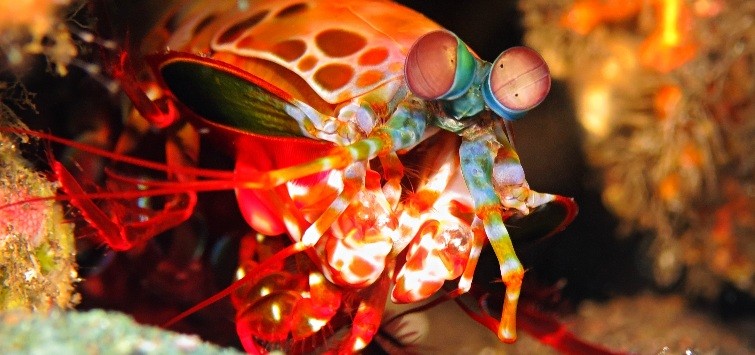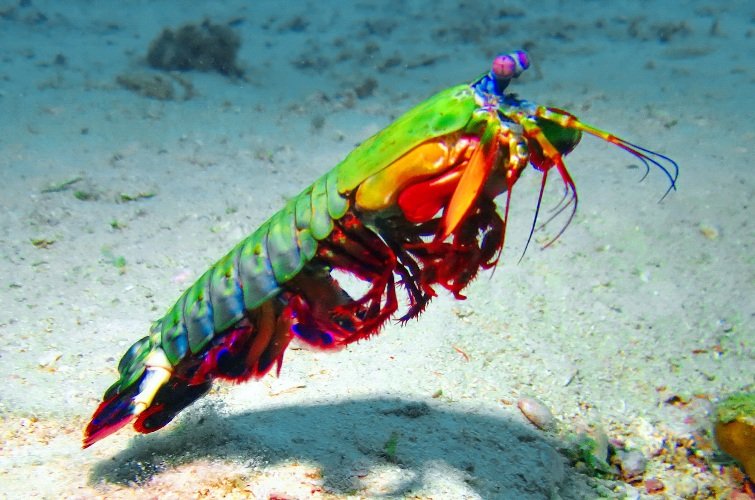Through the Eyes of a Mantis Shrimp
Author: Chris Sergeant
My first wild encounter with those mantis shrimp eyes came on the reef flats of Pulau Hoga, an idyllic tropical paradise located deep in the heart of the Indo-Pacific coral triangle. I was working with a team conducting fish counts across the isolated coral outcrops, hovering a couple of meters above the ocean floor, when my gaze was drawn to a juvenile banded sea krait snaking its way across the sand.
Highly venomous, these curious serpents would probe every crevice in search of their favored prey, anguilliform eels, but their interest was equally piqued by floating objects bobbing at the surface. Unfortunately, while surveying in pairs, one of us—invariably me—was required to sport a luminous marker buoy, designed to alert nearby boats of our presence, attached to an ankle by a length of rope.
Like a moth to a flame, the snakes would rise up to investigate these colorful floats. It was always slightly disconcerting to glance over my shoulder and see a set of black-and-white coils ironically entwined around what should have been a safety device a mere foot or two away.
But this particular krait’s inquisitive nature would be its downfall. It approached a burrow set a foot or two away from the coral bommie and delved in headfirst. Within seconds, it started to violently jerk, clearly attempting to retreat. The thrashing continued for a few seconds before the snake relaxed, flipped on its side, and lay still, dead. The body then inched slowly into the hole until any trace of the struggle had vanished and calm was restored.
With 10 minutes of survey time left, I was in a unique position to wait, hovering in hope that the krait slayer would reveal itself. Sure enough, a pair of stalked eyes penetrated the gloom of the burrow entrance. The culprit was a peacock mantis shrimp (Odontodactylus scyllarus). A crustacean killing a snake may initially sound far-fetched, but a closer inspection of the mantis shrimp’s weaponry reveals a supremely adapted hunter capable of ensnaring prey much larger than itself.
Fight Club
The reputation of the mantis shrimps—scientifically known as stomatopods—precedes them: thumb splitters, tank smashers, unwanted hitchhikers. But these sophisticated creatures are more than just a pair of brutal appendages. With more than 450 species known to science, they can be found throughout the world’s temperate and tropical oceans, with the largest topping 12 inches (30 cm) in length.
Despite mantis shrimps’ vision and often resplendent colorations, your attention is instantly drawn to their raptorial appendages. They have three segments, the final section of which boasts either an enlarged club—these are the “smashers” like the peacock mantis—or a fiendish collection of up to 17 outward-facing spines—these are what the “spearers,” such as the zebra mantis (Lysiosquillina maculata), use to impale their victims.
Spearer mantis species rely on muscle power to flick their limbs outward, while smashers use a punching technique to overcome their prey, utilizing a lock-and-spring type mechanism. When retracted, a tiny saddle-shaped structure in their arm is compressed, storing energy like a coiled spring. When released, the limb flies forward at speeds of over 50 MPH (80 KPH), causing a blow similar in impact to a small-caliber bullet.
The action is so incredibly fast that a secondary release of energy occurs through a shockwave it produces in the water, a phenomenon known as cavitation, delivering a second blow to the prey. Even if the initial strike misses, the shockwave that follows it can be enough to stun their quarry. During combat with conspecifics, it is often the frequency and number of blows landed, rather than the punching force, that is key to victory.
The secret to their punch is in the composition of the chitin in the mantis’s club. Stacked in horizontal layers, with each set at a slightly rotated angle to the one above, it acts as a shock absorber, preventing the club from fracturing. So effective is the design that the aviation industry utilized this layout to develop more impact-resistant carbon-fiber aircraft panels.
An Eye for Detail

Their impressive weaponry is hard to miss, but their visual capabilities are also remarkable. Mantis shrimps have compound eyes with thousands of individual photoreception units—known as ommatidia—situated on an outwardly curving hemisphere.
Because of the curvature, the ommatidia do not face in one direction but are set at different angles so each covers a small area within a much wider field of view. Each ommatidia collects tiny snippets of information that feed into a composite image, so the mantis shrimp gets a complete picture of what’s around them.
Also, mantis shrimp eyes are split into three distinct sections, two flattened hemispheres and a mid-band running in between. This is called trinocular vision. While humans require both eyes to perceive depth of field, mantis shrimps can do it with just one. In addition, they have 12 to 16 different photoreceptors, as opposed to our three, enabling them to detect ultraviolet (UV) and polarized light too.
So, why the complex setup? The theory is that, firstly, it’s to do with speed. The raw output from each photoreceptor reduces their processing time, enabling them to determine predator from prey in a flash.
They also have crystalline cones covering their photoreceptors that are thought to effectively turn their eyes into UV detectors. Since fluorescence can be a secret tool for communication under the waves, this may enable them to locate even the most well-camouflaged prey items.
Mantis shrimp eyes contain even more surprises—stomatopods can also detect polarized light, waves of light that vibrate in the same plane. Sunlight typically travels in an uncoordinated, multidirectional fashion, but when it redirects off a surface, say, fish scales, it changes the way light is reflected, organizing it so that it vibrates in just a single direction, known as linear polarization.
They can also perceive circular polarization, whereby light travels in a helix shape. Specialized structures in their photoreceptors help convert circularly polarized light to the linear version, which they can then process.
Under particularly turbid conditions, light scatters and becomes circularly polarized, so this visual ability could help mantis shrimps distinguish prey and predators from their environment, but it may also act as a secret communication channel. Studies have shown that the sections of some species’ shells reflect circularly polarized light, with the reflecting body parts differing between males and females.
This provides a way to advertise to possible mates without detection. However, cephalopods can also detect linear polarized light, and, given that a number of them predate on shrimps, using circularly polarized light may provide a signaling method for the mantis shrimps’ vision only.
These stomatopod superpowers haven’t gone unnoticed, most pertinently in the field of cancer detection. Cancerous cells reflect polarized light differently than surrounding healthy tissues, and this occurs early on, prior to the onset of other symptoms. Not surprisingly, this discovery gave rise to cameras that are used in conjunction with endoscopes to detect polarization patterns on living tissue.
The structure and mobility of their stalked eyes is really the showstopper, though. Each eye can move independently through all three degrees of rotational freedom, meaning that they can move their eyes up and down and side to side, as well as twist them around their eyestalks.
Mantis shrimps employ the same gaze-stabilizing functions as other animals do to keep their view of the world steady as they move, but they continue to roll their eyes throughout the process. In humans, this would be like visually tracking a moving target while rolling your head through every vertigo-inducing rotation and angle possible.
For mantis shrimp, however, it doesn’t matter in which direction their eyes are orientated. It has no bearing on their actual vision or spatial perception. Essentially, up still means up, whatever angle their eye faces.
A Mantis Aquarium

For some, their reputation as destructive, thumb-splitting menaces can be off-putting, but the intelligent and fascinating stomatopods are great candidates for a species-only aquarium. Aquarists may come across other species from genera like Gonodactylus, Neogonodactylus , or Haptosquilla on occasion, but the two most commonly encountered are the aforementioned O. scyllarus, the peacock mantis, and L. maculata, the zebra mantis.
With its psychedelic suit of armor, O. scyllarus is one of the most eye-catching, but its Technicolor coat serves a purpose. When threatened, the peacock mantis coils its tail section around to display its vivid eyespots and scare off larger predators.
Not quite as gaudy, L. maculata sports alternating white-and-black/brown horizontal bands reminiscent of their equine namesake, which aids them in camouflaging against the background of their preferred silt or sandy habitat. Both O. scyllarus and L. maculata hail from the Indo-Pacific. O. scyllarus is the smaller of the two, reaching approximately 8 inches (20 cm) in length. L. maculata can grow to double that, thus requiring more tankspace to roam.
Both species require a deep sandbed, where they’ll excavate a complex burrow. Coral rubble, broken live rock, and pieces of shells will be incorporated into the burrow structure to add stability. Some mantis shrimp species also secrete mucus to mix into the sand, creating a kind of snot concrete to keep their burrow from collapsing.
PVC tubing can be buried in the sand to create ready-made tunnels, with live rock strategically placed around the entries for a more natural look. The peacock mantis will roam the tank, rearranging and exploring piles of live rock, while the zebra mantis will rarely stray from its burrow.
Motile tankmates are heavily constrained by these stomatopods’ predatory behavior. Mantis shrimps are best suited to a specimen-only aquarium. Fish, snails, crabs, and even hermit crabs are all likely to be eaten and should be avoided.
Corals won’t be consumed, but the mantis shrimp’s tendency to rearrange its tank, particularly an issue with the peacock mantis, means that anything not secured is liable to be moved without warning. It may also be incorporated into their burrow, and vanishing frags tend to be the norm.
Mantis shrimp appreciate low-light conditions, and if subjected to intense illumination will seldom emerge from their burrows. They can become incredibly stressed, and shell rot may occur. So, even if you were willing to risk most corals, this is not an ideal marriage.
Fast-growing, low-light corals can work with mantis shrimp, as can some types of macroalgae. Consider mushrooms, pulsing Xenia, clove polyps, and the like. Growth may be slow, but these can all thrive in a peacock shrimp tank.
Feeding is a straightforward affair, using a combination of meaty fare. Most frozen aquarium foods will be taken, such as krill and mysid shrimp. Pieces of single-ingredient foods, such as small shrimp, squid chunks, or cut fish can be offered using tongs (never your fingers!).
Some aquarists have met with success offering a variety of sinking pellet foods, too, which can add some vegetable matter to the shrimp’s diet. Smashing mantis shrimp should also be given some hard-shelled prey, such as snails, small mussels, or clams, in addition to these other foods.
Mantis shrimp thrive under standard reef aquarium conditions and need optimal water chemistry. High nutrient levels are toxic to them, and the aquarium should be kept stable. This can be challenging to accomplish in a small tank.
A mantis shrimp is an excellent candidate for a reverse refugium aquarium attached to a reef tank (see TFH Nov/Dec 2022 for more information on reverse refugia). A small tank plumbed into the main reef tank allows the aquarist to use all of the same equipment, allowing the small tank the benefit of a larger water volume, skimmer, and filtration system.
However, care should be taken to ensure that all plumbing connections between the two are adequately screened: You do not want your mantis shrimp to have a tunnel into your main reef tank! Frequent water changes with premixed, high-quality water are a must.
Care must be taken when interacting with a mantis shrimp, or even just its tank. Accidents during feeding or maintenance can result in serious injury. Those powerful raptorial appendages make short work of fish, crustaceans, and mollusks, and they will think nothing of striking out at a stray finger or hand.
Whenever you’re working in the aquarium, make sure you know where the mantis shrimp is, and remember that they can be devastatingly quick. Also keep in mind that the burrow system can be extensive, with multiple entrances and exits; a shrimp can quickly enter a tunnel at one end of the tank and emerge on the other, next to your fingers. Tongs, grippers, and long-handled algae scrapers are essential tools.
Like all crustaceans, mantis shrimp have exoskeletons that they will need to shed as they grow. This process, known as molting, leaves the shrimp’s “shell” in the tank. Some individuals may eat it, but it is often left discarded.
Aquarists sometimes see these molts and believe their shrimp has died. Be aware that when attempting to remove the “dead shrimp,” the actual live shrimp may be nearby! Fortunately, it may not yet have a hardened exoskeleton to maximize its attack.
Upon shedding, the shrimp will need a very secure spot in which to skulk while their new shell hardens over the next day or two. They are extremely vulnerable at this point and should not be fed. Any live food that has been offered should be carefully removed, without disturbing the shrimp.
Beautiful Aliens

Mantis shrimp have incredible vision and quick reflexes, combined with their beautiful, alien appearance and predatory nature, make them animals of true mystique. While many aquarists might scoff at the idea of an aquarium devoted to only a single creature, the mantis shrimp is worthy of its own tank. Just be sure to mind your fingers when working in it!




